When I went to journalism school (#alternativefact), I was taught to open an article with a question, draw the audience in, discuss my thoughts, and then at the end of the article, answer the question. But I’m going to reverse that school of thought and answer the question first.
So, should you buy the Nima Sensor, the product that tests for gluten and was released to the public yesterday? Well…it all depends on your expectations. Yeah…I know…lame answer. Let me explain.
About three months ago, the good folks at Nima sent me a Sensor to try out. At the time, I asked my wonderful community…yes that’s YOU…what you’d like me to test. I got responses. Lots and lots of responses. So did I run out to the store, buy a bunch of stuff for testing and get down to it?
Ummmm…no.
Not because I wasn’t enticed. Simply because, as much as I believe in the product and the people behind it (I’ve met them…sincerely good, smart, passionate folks), I knew that testing one part of one food item (i.e. one Cheerio) did not mean the entire box of Cheerios was safe. And if I posted my results, that would tell the community that yes…Cheerios are indeed safe, when I don’t think they all are.
So the Nima Sensor sat on my book shelf. And sat. And sat. Then a few weeks ago, a saw an Instagram post from Nima Sensor that showed McDonald’s fries being tested and they came back gluten-free. I wrote about McDonald’s fries being gluten-free before and the risk is simply too high. I thought it sent a mixed message to the community, so I emailed the folks at Nima. Here’s how the conversation transpired:
For my testing, I was going to test Cheerios. But odds are, the box I test would pass. Does it mean they’re all safe? Not in my mind. And this holds true on a lot of foods out there. By me posting test results is saying that this food is ok and I can’t say that and firmly believe it.
So I am not going to use the Nima at this point and would be happy to send it back to you.
Nima: Thanks for the thoughtful response and perspective. It seems you are concerned with providing a false sense of security for folks if you test a sample of something that comes-up gluten-free and having users think that a certain product will always be gluten-free, relying on just a pea sized sample for all future decision making of eating a certain product or dish.
We are always striving to best position Nima to our users so it’s one additional data point to supplement what consumers are already doing for diligence when eating either packaged foods or restaurant dishes, and not a guarantee. In fact, we see users sometimes choosing to not eat food even when they get a smiley face because the response from waitstaff made them uncomfortable and untrusting about a particular dish. Sometimes we see Nima users eat the food despite the fact that they get a gluten found response. From the app data, we see that ~30% (Dude note: Holy sh*t!!) of tested gf labelled menu items have gluten, even for that one sample!
I think if you use the device, you can be in a great position to help us better position Nima to your community users to make sure they use it as one extra data point and not a decision.
I LOVED this honest response, and it’s why I stand so much behind their team. The Nima is just another tool in your toolbox and that is exactly how it should be approached. So I kept the Nima and gave it a shot. Here’s how it went down.
1) First, I had to decide what to test. I wanted to test something I knew wasn’t gluten-free first and then test something that was probably gluten-free. So off to the store and I got a box of Raising Bran (first ingredient: wheat flour) and a box of Honey Nut Cheerios (side note: it still makes my puke that the Celiac Disease Foundation has their logo on the box.)
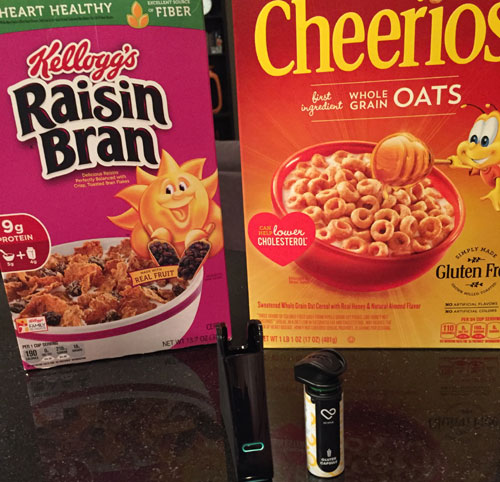
2) I opened the package. Sleek, simple, beautiful. From the packaging to the product itself. It honestly reminds me of an Apple product. And considering it comes charged, I was ready to go.
3) First up, Raisin Bran. The test is very simple to do and being that I’m a tech geek, it was also VERY COOL. A small bit of Raisin Bran in the capsule, put the capsule in the Nima and wait. Takes about three minutes. The result? A picture tells a thousand words.
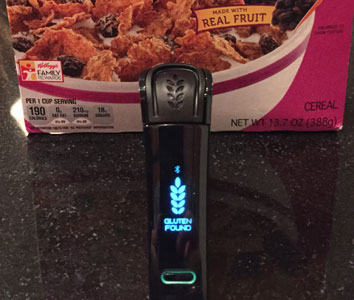
4) Next, I pulled one raisin out of the box of Raisin Bran to test. I was curious if it would pick up the wheat that surrounds the raisin itself in the box. Result? Gluten Found. Ok…I’m impressed.
5) Next up was the Honey Nut Cheerios. I had a feeling it would pass. And pass it did.
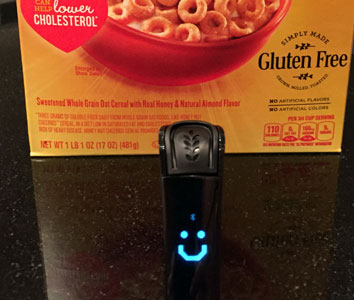
And at that…my little science experiment was over. Did I then proceed to have a bowl of Cheerios? Of course not. Their testing methods suck. Many in our community continue to get sick from them. And I still have nightmares about my visit to their facility.
So let’s recap:
Yes…I believe in the product and the people behind it.
No…I don’t think it should be used as the ONLY parameter if something is safe or not.
Yes…I think it’s totally cool and a step in the right direction.
No…I don’t think you should eat Cheerios.
SO DUDE, SHOULD I BUY IT? Your call my friends (and please turn your cap lock off!). And if you do, here’s the link and here’s a coupon for you: NimaDude. It will get you $10 off the Starter Kit.
Just remember, it’s a tool in your toolbox. Use it wisely.

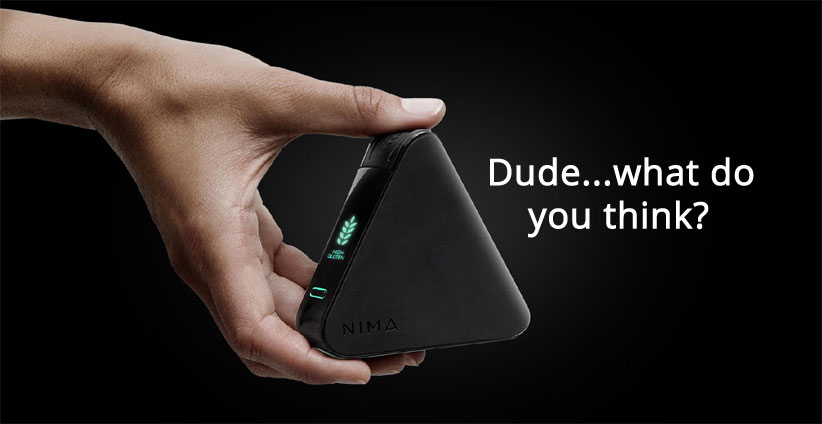
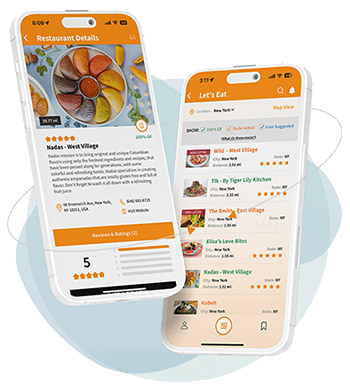
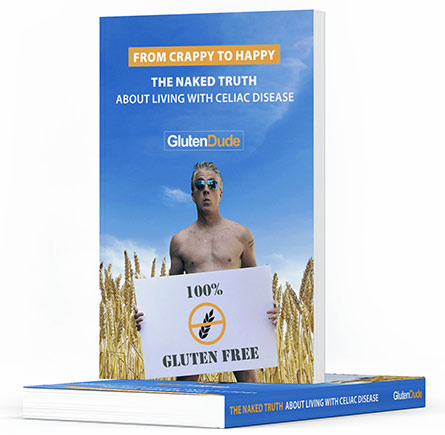


We got one, and I’m thinking more for restaurants that say they have gluten-free options, like PF Changs, CPK, and some of our local options. I might test some of the stuff that’s “Manufactured on equipment…” or “In a facility with …” just to see what happens. It looks cool though. Is it just yes or no? or does it give a level/number?
If you don’t subscribe to the Gluten Free Watchdog, you’re doing yourself a disservice. We owe Tricia a huge debt. https://www.glutenfreewatchdog.org/news/lateral-flow-devices-nima-gluten-tox-home-ez-gluten-to-test-food-for-gluten-manufacturer-consumer-use/
Basically, unless you can take your whole meal, mash it into a homogenous mass, then test a sample for gluten, it’s not going to detect cross contamination.
If you, however, want to check surreptitiously that a server brought you rice noodles and not wheat noodles, then sure – use your Nima.
I think I’d rather go with the gluten-sniffing dog. At least they have other benefits. http://www.lansingstatejournal.com/story/news/local/2014/09/22/gluten-detecting-dog-celiac/16070397/
Where do I get one of those dogs?
thank you for sharing!!!
The Nima sounds cool and great, honest review and conclusions Dude (and Nima).
I think it will be very helpful for many.
Unfortunately for me, it’s not conclusive enough for me to start eating out again. I’ve chosen to go hungry, if necessary, instead.
The Nima and your conclusions further establish how insidious and complex a disease from which we suffer actually is. I told a buddy just yesterday that I’d not be as concerned about ingesting only a tiny bit of gluten as long as all I had to endure was a little upset stomach or some itching. What aggravates the crap, literally, out of me is the firing up of months of systemic autoimmune responses resulting from such a tiny amount of gluten cc such that it’s no longer worth ANY risk especially since I’ve currently overcome, I hope, my gluten caused cancer and retina damages.
My sincere gratitude to the great folks at Nima for trying to and/or making our lives better! Hear hear !!!
I’ll buy one, not so much as a tool, but more as a toy. 😉 When everyone is busy devouring their gluten laden wonders, I won’t feel the need to leave the table to avoid making anyone feel uncomfortable – seeing me with fork in hand, napkin tucked into my shirt, and an empty spot where a plate should be. My shiny new toy will be a marvellous distraction, and a win-win for all involved!
I have to agree with some of comments above. I have such anxiety about eating out. Just the other night I went to dinner with my husband. Asked for gluten free meal. When the meal came they said it was, I was questioning the sauce. Had them confirm it was gluten free. I ate it and got sick. If I could of tested it, I could of said no and sent it back.
I have a question about the “capsule” in which the food is to be tested: is it the same capsule used every single time? Or is it a disposable one? My point being that cross contamination and false results will ensue if one puts different foods in same cavity…..
It’s a one time use capsule
Thanks
Dude, I had an interesting use case this week. Both my kids reacted as if they had gluten. They had two things that were supposed to be gf (that I didn’t make). Tested the product I was suspicious of with the Nima. Gluten Found. Mystery solved. Very useful. Contacted company. Hopefully saved someone else.
I ordered one months ago and it just said it shipped! Unsure of how to handle finding gluten in a meal at a restaurant. I think you “eat at your own risk” and would most likely just not eat it, vs sending it back and trying again and again. This would make me not return to said restaurant though. Would be interesting in seeing how others handle the restaurant scene when they order GF, but their Nima says “gluten found”.
For many of us, the cost is simply prohibitive. There’s $5-$6 per test on top of the $270 unit, not to mention the cost of the suspect food that you might have to throw away. I suppose if money wasn’t an issue (and their website says some people have been able to use their HSA money to pay for it), it could be a useful tool to track down the source of a gluten exposure. Or if you have to travel a lot.
That’s my problem too. Cost is too high and even more in Canadian dollars… too sad… I could almost get it… I’m off by about $100. Would hope they have some kind of boxing day special…
On the usefulness of it I would say that a positive on the screen is always a positive so that’s a no-no to eat and if it’s in a restaurant that told you their food is GF, you can prove they are wrong and avoid getting sick. But I would often suspect of a negative in the Nima and use it as an extra data point in each situation. I would also try to mix parts of the dish in one sample instead of texting only one item. Another point is the retrospective testing: if I got sick yesterday in my house and I’m not sure what made me sick I can test a couple items I’m suspecting of and find it…. I would then throw the role pack in the garbage avoiding getting sick another time. But in all case you can’t trust blindness, it’s always a judgement call.
Hi GD,
How many trials did you run on the Cheerios, and how many pieces of the cereal were in each trial? It sounds from the OP that you checked it once only. My suspicion is that you would get a positive if you ran enough trials, although I’m not sure how many that would be. Also, there may be some variability from one lot to the next so you may have just lucked into a box from a good lot, or you might have gotten one of the better boxes from a lot that could have its share of fails.
The next lot, box or even another sample from the same box could just as easily test positive, so I’d be interested to hear how that would turn out if you were willing to give it a go.
Are you planning to test foods you yourself eat to see where they come out? I know from time to time on here you speak of feeling as though you’ve been glutened.
Came across this recent review of the Nima in Popular Science from someone with celiac – she ran into a lot of the same issues you identify. Thought it might be of interest!
http://www.popsci.com/gluten-sensor-test-review
The other thing to note is that the Nima uses the same lateral flow technology as most tests on the market, just in a fancy package. Big difference here is that other tests are targeted at food manufacturers, not consumers. The vast majority of consumers don’t know that these tests are useless for fermented and hydrolized foods. That means if there is vinegar, wine, fermented vegetables of some kind (kimchi, pickles, saurkraut, etc) then you will get an inaccurate result.
I suspect this is part of the reason so many GF restaurants have seem failing test results.
I’ve been using NIMA and feel more comfortable while eating out. It’s a great equipment to give Celiacs a piece of mind to guarantee that the food is indeed GF. I would like to add that NIMA Sensor does not test for Oats. They have it in their website and also by FDA oat is not considered gluten, even though it makes Celiacs sick.
“Corn, rice, and oats, while glutinous (meaning “like glue in texture”) do not contain the same gluten protein found in wheat, barley, and rye that people with Celiac disease or gluten sensitivities react to, so Nima doesn’t search for corn, rice, or oats in samples of food. Nima would however search for gluten contamination in those foods.”
I hope it might clarify the cheerios testing.
Oats make celiacs sick? I didn’t know this and I’ve been diagnosed for over 15 years. I had heard that some oats are cross contaminated, but not the oats themselves. Thanks for the info. Now I’ll research that.
Dear Gluten Dude,
I think Nima sensor is becoming more of a hinderance than one tool in a tool box for celiacs. This start up company is introducing a product to consumers before it should be brought to market and all proper testing has been done. The company still lacks third party validation and peer review from the scientific community. In addition, I’m quite unsatisified with the way they are educating their consumers. The other day I contacted a “dedicated” gluten free bakery in my city that recently started hosting a night time pop up that sells cake batter (not gluten free). The owner in part backed up his claim that this was safe because a rep from Nima had recently visited the bakery and their products had all produced a smiley face …so he insisted that they are absolutely still safe for those with celiacs! Recent start up companies that have poorly dealt with similar miseducation or lack of adequate consumer education or improper testing (i.e. Validation) that come to mind are 23andme and thernos. The difference here is that these companies were held accountable. I’m pretty disappointed with Nima as a company and I think they are taking advantage of the celiac community.
I am interested in a Nima. It’s not to test something that could be cross-contaminated, of course. It may be a retroactive tool. Example: I started a food diary when I got unexpectedly sick. If I get sick, I put every item I ate that day on the “no way” list. I know it would be expensive, but maybe I could test the suspected culprits and keep some items on my “safe to eat” list. I believe each use is $8 to $10 bucks for the capsule? A small price when you look at the payoff. Whenever I get sick, I’m often confused what it was that did it. Maybe this could help.
There is an update from Gluten Free Watchdog that I found more quantitative in its evaluation of Nima and unfortunately not in a good way:
https://www.glutenfreewatchdog.org/news/gluten-free-watchdogs-updated-position-statement-on-the-nima-sensor-for-gluten/
Hoping that a gadget like that is not too hard to use and is actually reasonably accurate is possible in the future.
I am livid at how unhelpful you are. What if someone was getting sick and wanted to test everything to figure out what had gluten. I don’t understand how you refused to test this all of the place and give us a helpful review. Thanks for literally nothing.
Is this directed at me?
If anyone wonders of a gluten free versioned raisin bran, greenwise does a gluten free recipe of raisin bran with the flakes made of rice and corn with no common malt. The common version was theirs in the 1st place, it was nice of them to change the recipe to such unique version in favor of the gluten free empire.